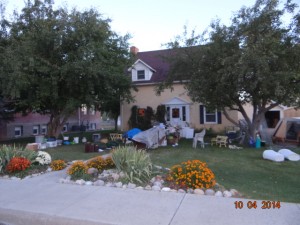Do you ever wonder if a house can have a personality? Can it feel? Does it have a relationship with its inhabitants? A house is built with inanimate objects–wood, metal, stucco, wall board, insulation. How can a house have human emotions? Yet, when we look for a house or apartment we seek a certain feel or vibe: cozy, comfortable, elegant, or streamlined. We might say, while house hunting, It feels right. It feels peaceful. Conversely, we might say a house has a bad vibe. Such language suggests that a house has personality. Or, are we simply projecting a feeling that reflects our own personality and pursuits?
And, what about a house built with plant matter and/ or soil? House Alive teaches cob home construction, which uses a mixture of sand, straw, and clay. Carolyn Roberts built a house from straw bales. Many people believe that organic materials can sense and feel. At the very least, they release energy, according to the laws of physics. Can we sense the energy? Does it imbue the house with personality?
Most sane people would answer NO to these questions about a house having personality and feelings. However, a sane and well-educated writer–David Abram–says that houses can feel. In his book, Becoming Animal: An Earthly Cosmology, Abram writes,
The undulating grain and the irregularities in the wood beckon gently to my animal flesh, echoing the wavelike lines around my knuckles and the knots in my muscled shoulders, evoking the imperfect and improvisational character of all earthborn beings. It is a character also present in stone and in the unseen currents rippling the clouds outside that window, and the cracks slowly spreading in the painted plaster of these walls (as gravity quietly invites the house to settle more intimately into the ground). There’s an affinity between my body and the sensible presences that surround me, an old solidarity that pays scant heed to our over-educated distinction between animate and inanimate matter…The Friendship between my hand the this stone enacts an ancient and irrefutable eros, the kindredness of matter with itself.
In the same chapter, Abram tells the story of his wife and infant daughter taking a two-week trip to visit relatives. When Abram returns from taking them to the airport, he finds that the house is sad. When he tells the house that the baby will be back soon, the house sighs in relief and the vibe changes. Abram writes
As I pried off my boots and slung my pack onto the counter, I notices that something was amiss. Something about the house was distressed, disturbed…The walls, the ceiling, the low tables, and even the windows were all glaring at me…The whole interior felt heavy, oppressive..But the baby will be back, I said to no one in particular….Straightaway the room lightened up. The furniture relaxed, the ceiling stopped glowering. The structure of the house eased and loosened, the walls and the wood beams settling back…The space no longer felt accusatory; indeed, the space no longer appeared to pay me any attention whatsover.
Abram admits that he felt doubt at first, and that later, his friends explained the incident as an episode of projecting his own feelings of missing the little one onto the house. However, Abram insists that the feelings of the house were genuine. He also writes,
“One’s relation to one’s house, in other words, is hardly a relation between a pure subject and a pure object–between an active intelligence, or mind, and a purely passive chunk of matter.”
Is it just me or does Abram’s prose make it seem easy to believe that people and their houses can connect? I want to believe what he says. As a person of faith I am accustomed to believing in the unseen, the unknowable. So, what Abram writes doesn’t seem so totally strange. Besides, I have always felt a deep connection with my yellow house in Wheatland, which I vacate in a few days.
to be continued….

Yard sale at the Yellow House

